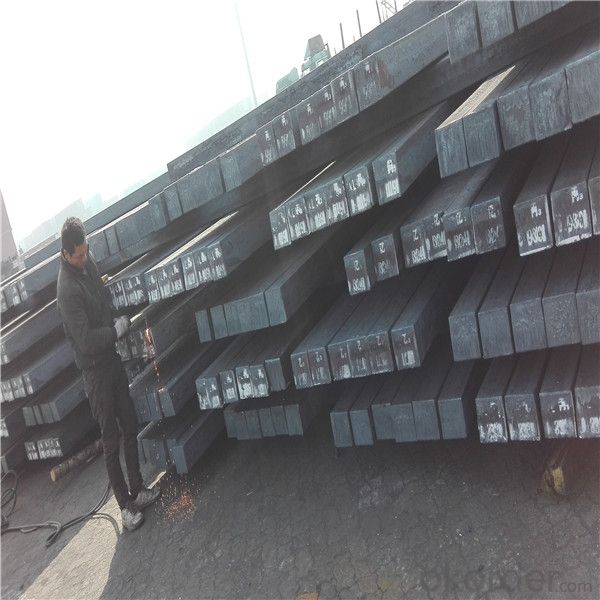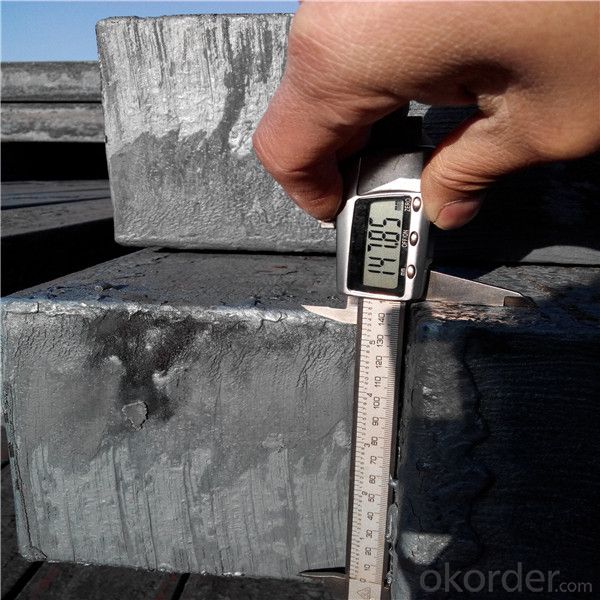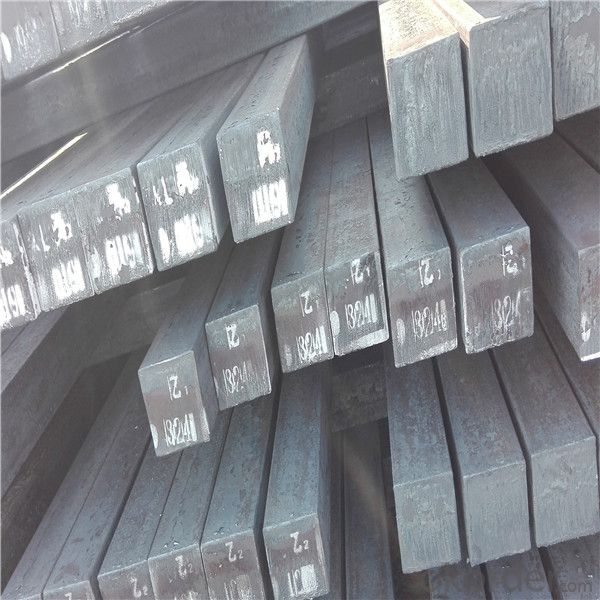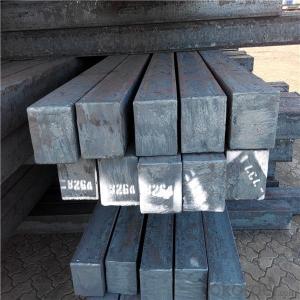Prime concast square steel billet in different size
- Loading Port:
- China main port
- Payment Terms:
- TT OR LC
- Min Order Qty:
- 1000 m.t.
- Supply Capability:
- 18312 m.t./month
OKorder Service Pledge
OKorder Financial Service
You Might Also Like
Item specifice
Steel billet :
Steel billet(ingot) by cogging or breakdown of semi-finished products, is the raw material of all kinds of steel mill. Billet section of square, round, flat,
rectangular and abnormity of several kinds of, mainly related to the shape of rolled products.
The billet is mainly divided into two kinds from the shape:
Slab: cross section width and height of the ratio of the larger, mainly used for rolling plate.
Billet: equal cross section width and height, or a huge difference, mainly used for rolling steel, wire rod. ,
Gade:
Standard | C(%) | Mn(%) | S(%) | P(%) | Si(%) |
Q195 | ≤0.12 | ≤0.50 | ≤0.040 | ≤0.035 | ≤0.30 |
Q235 | ≤0.20 | ≤1.40 | ≤0.045 | ≤0.045 | ≤0.35 |
Q275 | ≤0.22 | ≤1.50 | ≤0.045 | ≤0.045 | ≤0.35 |
20MnSi | 0.17-0.25 | 1.2-1.6 | ≤ 0.050 | ≤ 0.050 | 0.40-0.80 |
3SP | 0.14-0.22 | 0.40-0.85 | ≤ 0.050 | ≤ 0.040 | 0.05-0.15 |
5SP | 0.28-0.37 | 0.50-1.00 | ≤ 0.050 | ≤ 0.040 | 0.15-0.30 |




Our Advantage
* Professional Personnel of Steel Trading
* Strong Steel Industry Background
* Conveniently Geographic Location
Our Commitment
* Sincere, Practical, Efficient and Developing
* High Quality Steel Production
* Competitive Price and Timely Delivery
Packing :
Within 30 days
1.Standard export package
2.In bundles with steel strips
3.As the requirements of the customers
FAQ:
Q: How to get quotation?
A: When we receive your detailed enquiry, we will set the best price based on standard,
steel grade, outer diameter, wall thickness, quantity, country.
And we will send quotation to your mailbox.
Q:How to guarantee the quality of the products?
A:We have established the international advanced quality management system,every link from raw material
to final product we have strict quality test;We resolutely put an end to unqualified products flowing into the market.
At the same time, we will provide necessary follow-up service assurance.
Q:How long can we receive the product after purchase?
A :In the purchase of product within three working days, We will arrange the factory delivery as soon as possible.
The pecific time of receiving is related to the state and position of customers.
- Q:What are the different types of cutting processes used for shaping steel billets?
- There are several different types of cutting processes used for shaping steel billets, including sawing, shearing, and flame cutting. Sawing involves using a saw blade to cut through the billet, while shearing uses a machine with two blades to cut the billet in a straight line. Flame cutting, on the other hand, involves using a high-temperature flame to melt and cut through the steel. Each process has its own advantages and is chosen based on factors such as the desired accuracy, speed, and cost-effectiveness of the cutting operation.
- Q:Are steel billets used in the production of construction equipment?
- Yes, steel billets are commonly used in the production of construction equipment. Steel billets serve as the raw material for various components and parts of construction equipment, such as frames, chassis, brackets, and support structures. The high strength and durability of steel make it a preferred choice in the construction industry, ensuring the equipment's ability to withstand heavy loads and harsh working conditions.
- Q:How do steel billets contribute to the overall fire resistance of a structure?
- Steel billets contribute to the overall fire resistance of a structure in several ways. Firstly, steel is a non-combustible material, meaning it does not burn or contribute to the spread of fire. By using steel billets in the construction of a building, the risk of fire propagation is significantly reduced. Secondly, steel has a high melting point, typically around 1370 degrees Celsius. This means that even in the presence of intense heat, steel maintains its structural integrity and does not deform easily. Steel billets, which are solid blocks of steel, provide strength and stability to the structure, ensuring that it can withstand the impact of a fire. Additionally, steel has a low thermal conductivity, meaning it does not conduct heat easily. This property helps to slow down the transfer of heat from the fire to the surrounding areas of the structure. By acting as a barrier, steel billets prevent the temperature from rising rapidly, giving occupants more time to evacuate and firefighters more time to extinguish the fire. Moreover, steel billets are often used in the construction of fire-resistant walls or barriers within a structure. These walls are designed to compartmentalize the building, limiting the spread of fire and smoke to specific areas. By incorporating steel billets into these fire-resistant walls, the construction becomes more robust and capable of withstanding the extreme conditions of a fire. In summary, steel billets contribute to the overall fire resistance of a structure through their non-combustible nature, high melting point, low thermal conductivity, and ability to reinforce fire-resistant walls. By utilizing steel billets in the construction process, buildings can be made more resilient to fire incidents, ensuring the safety of occupants and minimizing the damage caused by fires.
- Q:What are the main factors affecting the dimensional tolerances of steel billets?
- Various factors can influence the dimensional tolerances of steel billets. The manufacturing process itself is one of the main factors. The method employed to produce the billets, whether it be casting or hot rolling, can impact the final dimensions. Casting processes, for instance, can introduce variations in the cooling rate, thereby affecting the overall shape and size of the billets. Another crucial factor is the initial quality of the raw material. The composition and homogeneity of the steel utilized in billet production can contribute to dimensional variations. Impurities or uneven distribution of alloying elements can result in inconsistencies in the size and shape of the billets. The temperature maintained during the manufacturing process is also significant. High temperatures have the potential to cause thermal expansion, leading to dimensional changes in the billets. Proper control of cooling rates and the cooling process is vital to maintaining the desired tolerances. The design and condition of the manufacturing equipment can also impact dimensional tolerances. Adequate maintenance and calibration of machinery are essential to ensure consistent and accurate production. Lastly, external factors like handling and transportation can affect the dimensional tolerances of steel billets. Improper handling or rough transportation conditions can result in physical deformations or damage to the billets, leading to variations in their dimensions. In summary, achieving the desired dimensional accuracy in steel billets necessitates attention to factors such as the manufacturing process, raw material quality, temperature control, equipment condition, and handling and transportation practices.
- Q:What are the environmental impacts of producing steel billets?
- The production of steel billets has several environmental impacts. One of the main concerns is the emission of greenhouse gases, particularly carbon dioxide (CO2), during the steelmaking process. Steel production is a significant contributor to global CO2 emissions, as the process requires high temperatures and the use of fossil fuels, such as coal or natural gas, to extract iron from iron ore. The combustion of these fuels releases CO2 into the atmosphere, contributing to climate change. Another environmental impact of steel billet production is the generation of air pollutants. The use of fossil fuels in steelmaking can result in the release of sulfur dioxide (SO2), nitrogen oxides (NOx), and particulate matter, which contribute to air pollution and can have negative effects on human health. Additionally, the production of steel billets often involves the use of additives and chemicals, which can further contribute to air pollution if not properly managed. The extraction of iron ore, which is a primary raw material for steel production, can also have significant environmental consequences. Mining activities can lead to deforestation, habitat destruction, and soil erosion. Furthermore, the extraction and transportation of iron ore require the use of heavy machinery and vehicles, which consume energy and contribute to air pollution. Water usage is another environmental concern in steel billet production. Steelmaking processes require substantial amounts of water for cooling, cleaning, and dust suppression. The extraction and treatment of water, as well as the discharge of wastewater, can have adverse effects on local water sources, particularly if not properly managed or treated. Lastly, the production of steel billets also generates waste and by-products. Steel slag, a by-product of the steelmaking process, can contain heavy metals and other pollutants. If not properly treated or disposed of, these by-products can contaminate soil and water resources. Overall, the production of steel billets has significant environmental impacts, including greenhouse gas emissions, air pollution, water usage, and the generation of waste and by-products. To mitigate these impacts, efforts are being made to develop cleaner and more energy-efficient steelmaking technologies, increase the use of recycled steel, and improve waste management practices in the industry.
- Q:What are the environmental impacts of manufacturing steel billets?
- The manufacturing of steel billets has significant environmental impacts due to the extraction and processing of raw materials, energy consumption, and waste generation. 1. Raw material extraction: The primary raw materials used in steel billet production are iron ore, coal, and limestone. Extracting these resources often involves mining, which can lead to deforestation, habitat destruction, soil erosion, and water pollution. Additionally, the extraction of iron ore requires large amounts of water, which can strain local water supplies. 2. Energy consumption: Steel billet production requires high temperatures, typically achieved through the combustion of fossil fuels such as coal and natural gas. This process is energy-intensive and contributes to greenhouse gas emissions, including carbon dioxide (CO2) and nitrogen oxides (NOx), which are major contributors to climate change and air pollution. 3. Air pollution: The combustion of fossil fuels in steel production also releases particulate matter (PM), sulfur dioxide (SO2), and other pollutants into the air. These emissions can have detrimental effects on human health, causing respiratory problems and contributing to the formation of smog. 4. Water pollution: Steel manufacturing generates wastewater containing various chemicals and heavy metals. If not properly managed, these pollutants can contaminate water bodies, harming aquatic ecosystems and posing risks to human health. Additionally, the cooling of steel production equipment often requires large amounts of water, leading to water scarcity in some areas. 5. Waste generation: Steel production generates significant amounts of waste, including slag, dust, and sludge. These by-products can contain toxic substances and require careful handling and disposal to prevent soil and water contamination. To mitigate these environmental impacts, various measures can be implemented. These include adopting cleaner production technologies, improving energy efficiency, promoting recycling and reuse of materials, implementing effective waste management practices, and investing in renewable energy sources. Additionally, companies can work towards reducing their overall carbon footprint by implementing carbon capture and storage technologies or transitioning to low-carbon energy sources such as electric arc furnaces powered by renewable energy. Furthermore, government regulations and international agreements can play a crucial role in enforcing environmental standards and promoting sustainable practices in the steel manufacturing industry.
- Q:How are steel billets used in the manufacturing of shipbuilding parts?
- The manufacturing of shipbuilding parts heavily relies on steel billets, which are vital in this process. These billets are essentially semi-finished steel products, usually in the form of rectangular or square bars, and are utilized as raw material for further processing in shipbuilding. To initiate the process, steel billets undergo rolling, where they pass through a series of rollers to decrease their cross-sectional area and increase their length. This rolling process converts the billets into elongated, slender sections of steel known as plates or sheets. These plates or sheets are then employed to fabricate diverse shipbuilding components, including hulls, decks, bulkheads, and superstructures. After the rolling process, the steel plates or sheets are cut into desired sizes and shapes using cutting machines or torches. These cut pieces are subsequently molded, bent, and welded together to form the necessary shipbuilding parts. For example, the steel plates can be bent and welded to create curved sections for the ship's hull, or they can be shaped into intricate forms for other components. Furthermore, steel billets are also utilized in the production of forged shipbuilding parts. In this scenario, the billets are heated to high temperatures and then subjected to intense pressure to reshape the steel. This forging process results in shipbuilding parts that are stronger and more durable, often used for critical components such as propeller shafts, crankshafts, and turbine blades. In conclusion, steel billets serve as the starting point in the manufacturing of shipbuilding parts. Through processes such as rolling, cutting, molding, and forging, these billets are transformed into plates, sheets, and forged components, all of which are crucial in constructing the various structural and functional elements of ships.
- Q:What are the challenges faced in the production of steel billets?
- The production of steel billets encounters various obstacles. One major hurdle is the acquisition of raw materials. Typically, steel billets are created from iron ore, which must first be mined and processed. However, the availability and quality of iron ore can fluctuate, making it difficult to maintain a consistent supply. Another challenge arises from the energy-intensive nature of steel production. Converting iron ore into steel billets demands significant amounts of energy, primarily in the form of electricity and fossil fuels. Consequently, this results in high production costs and contributes to environmental concerns, including greenhouse gas emissions. In addition, the production of steel billets involves intricate metallurgical processes. The steel must be heated to high temperatures and undergo various treatments to achieve the desired properties. Ensuring consistent quality and meeting customer specifications can be problematic, as even slight deviations in the production process can impact the final product's performance. Maintaining a safe working environment poses a considerable challenge in steel billet production. The process involves handling heavy machinery, molten metal, and potentially hazardous chemicals. Effective safety measures and protocols must be implemented to safeguard workers and prevent accidents. Lastly, market dynamics and competition within the steel industry create hurdles in the production of steel billets. Fluctuating demand, changes in customer preferences, and price volatility can affect production planning and profitability. Steel producers must remain competitive by continuously improving efficiency, reducing costs, and adapting to market trends. In summary, the production of steel billets faces challenges related to raw material sourcing, energy consumption, metallurgical processes, safety, and market dynamics. Overcoming these obstacles necessitates a combination of technological advancements, efficient operations, and strategic decision-making to ensure a sustainable and successful production process.
- Q:How are steel billets cast into shape?
- Steel billets are cast into shape through a process called continuous casting. This involves pouring molten steel into a water-cooled copper mold, which allows the steel to solidify and form a continuous billet. The billet is then further shaped and molded into its desired form through rolling or forging processes.
- Q:What is the role of steel billets in the manufacturing of railway signaling systems?
- Steel billets play a crucial role in the manufacturing of railway signaling systems. These billets serve as the primary raw material for the production of various components that are essential for the functioning of these systems. Railway signaling systems are responsible for ensuring the safe and efficient movement of trains on the tracks. They comprise a complex network of electrical and mechanical devices that control the traffic flow, provide information to train operators, and maintain a safe distance between trains. To manufacture these systems, steel billets are utilized in several ways. Firstly, steel billets are used to produce the structural components of railway signaling systems. These components include signal poles, posts, and brackets that support the signaling devices such as lights, signals, and indicators. Steel is chosen for these structural elements due to its high strength, durability, and resistance to environmental factors such as wind, rain, and temperature fluctuations. Secondly, steel billets are employed in the production of various electrical components used in railway signaling systems. These components include wiring conduits, junction boxes, and mounting plates that house and protect the electrical connections and circuitry. Steel's electrical conductivity properties make it an ideal material for these applications. Additionally, steel billets are also utilized in the manufacturing of mechanical components within railway signaling systems. These components include gears, levers, and linkages that facilitate the movement and operation of the signaling devices. Steel's mechanical properties, such as its hardness and ability to withstand high loads, ensure the reliability and longevity of these mechanisms. In summary, steel billets are essential in the manufacturing of railway signaling systems as they provide the necessary raw material for the production of structural, electrical, and mechanical components. Their strength, durability, electrical conductivity, and mechanical properties make them well-suited for the demanding requirements of these systems, ultimately contributing to the safe and efficient operation of railways.
1. Manufacturer Overview |
|
|---|---|
| Location | |
| Year Established | |
| Annual Output Value | |
| Main Markets | |
| Company Certifications | |
2. Manufacturer Certificates |
|
|---|---|
| a) Certification Name | |
| Range | |
| Reference | |
| Validity Period | |
3. Manufacturer Capability |
|
|---|---|
| a)Trade Capacity | |
| Nearest Port | |
| Export Percentage | |
| No.of Employees in Trade Department | |
| Language Spoken: | |
| b)Factory Information | |
| Factory Size: | |
| No. of Production Lines | |
| Contract Manufacturing | |
| Product Price Range | |
Send your message to us
Prime concast square steel billet in different size
- Loading Port:
- China main port
- Payment Terms:
- TT OR LC
- Min Order Qty:
- 1000 m.t.
- Supply Capability:
- 18312 m.t./month
OKorder Service Pledge
OKorder Financial Service
Similar products
New products
Hot products
Related keywords





























